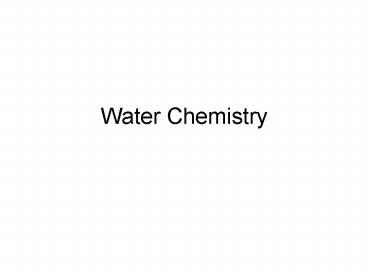Water Chemistry - PowerPoint PPT Presentation
1 / 26
Title:
Water Chemistry
Description:
flowing artesian wells are those abstracting water from two impermeable layers ... nonflowing artesian wells are those where the outlet is above the recharge zone ... – PowerPoint PPT presentation
Number of Views:56
Avg rating:3.0/5.0
Title: Water Chemistry
1
Water Chemistry
2
- Objective 1 exposure to the physical, chemical
and biological parameters which control the
composition of natural waters - Objective 2 become familiar with practical
methodologies used by todays aquaculturists
3
Lecture 1 Introduction, Water Sources
- Readings
- Tomasso, J.R. and Brune, D.E., 1991. Aquaculture
and Water Quality, The World Aquaculture Society,
Baton Rouge, LA. Pages 11-20. - Lawson,T.B., 1995. Fundamental of Aquaculture
Engineering, Chapman Hall. Pages 52-56.
4
Why Study Water Quality?
- Aquaculture produces a commodity and therefore
production must be standardized. - What are the environmental requirements for a
species? - How do we meet and maintain these during
production? - Does it influence the environment?
- Interdisciplinary approaches are often needed to
solve the problem!
5
Expectations/Limitations
- Conventional agriculture ? aquaculture
- Data base on aquatic organisms is small.
- Much data derived from native populations
aquaculture production isnt natural.
6
Expectations/Limitations
- Aquatic environment vs. gaseous environment
- Water universal solvent
- Aquatic organisms are exposed to much more
material (potential toxins).
7
Expectations/Limitations
- Another problem water is heavy (8.3 lbs., or
3.7 kg/ gallon)! - Makes it difficult to change environment.
- Must streamline energy efficiency in production
systems - Hydrosphere is also very non-dynamic compared to
atmosphere poor nutrient movement towards and
metabolite movement away from aquatics
8
Environmental Criteria
- Production, survival, growth, and reproduction of
aquatic animals is directly influenced by
chemistry of water, microbes and toxins. - Physical, chemical and biological factors are
interrelated - Aquaculture can also have a reverse effect on
environment (i.e., the environment is made
suitable for aquaculture)
9
Environmental Criteria
- Aquacutlured animals consume O2 and produce
metabolic byproducts. - Therefore, water chemistry is constantly changing
with respect to quality.
10
Thats enough Soup!
11
What is Water Quality???
- Chemicals dissolved in the water physical
attributes affecting them water quality - When we talk about good water quality we imply
that all attributes are present at an appropriate
level for whatever stocking density required - Often aquaculture water quality ? environmental
water quality - Good water quality criteria differ from species
to species
12
Non-natural Factors
- water filtration
- stocking density
- fertilization
- supplemental feeding
- aeration
- liming
- water exchange rate
- species cultured (bivalves vs. fish vs.
macroalgae) - chemical amendments
13
Part 2 Water Sources
- Supplies of quality water are decreasing.
- What is good for one species may be bad for
another. - Degree to which water quality can be allowed to
degrade is highly dependent upon waste generated
14
Water Sources
- Waste generated intensity of culture amount
(type) of feed added to the system - Key highest stocking density possible without
degrading water quality - Much depends upon the water source
15
- Seawater plentiful
- Freshwater scarce
- two options groundwater (wells) or surface
water (lakes, rivers) - other sources not considered rain, city water
16
Groundwater advantages
- Groundwater is preferred Why?
- More dependable, uniform over time, free from
competitors, competitors eggs, no predatory
insects. - Temperature nearly constant.
- Susceptibility to contaminants reduced.
17
Groundwater disadvantages
- Pollution septic fields, chemical and
radioactive dumps, landfills, agricultural
chemicals - Toxic gases NH3, hydrogen sulfide, methane, CO2
- Major disadvantage low oxygen, must be
recharged (injected), excessive iron, or metal
ions.
18
Aquaculture Groundwater
- Two major sources springs and wells
- springs exposure of an aquifer at the ground
surface or via a crack or fault in an upper area - wells human-built, accessing aquifer
- advantages usually clean, no pumping
- disadvantages yield varies, recharge requires
evaluation, ownership, permits, competition
19
Aquaculture Groundwater
- Well water is usually a good source for
aquaculture (freshwater) purposes - usually better than surface water, but must also
be pumped - cost of construction and pumping is high
- types of wells water table, flowing artesian,
and non-flowing artesian - water table wells are simply holes dug into the
water table of an aquifer
20
Aquaculture Groundwater
- shallow or water table wells are influenced by
rainfall - flowing artesian wells are those abstracting
water from two impermeable layers - the well outlet is of lower elevation than the
recharge zone, thus, flow by gravity - nonflowing artesian wells are those where the
outlet is above the recharge zone
21
Various Types of Groundwater
Lawson (1995, page 53)
22
Groundwater Sources
Comal Springs
23
Surface Water freshwater
- Fresh surface water sources include rivers,
streams, bayous, sloughs, lakes, ponds and
reservoirs - Require pumping, but cheaper than wells
- High levels of silt, predators, disease,
pesticides make them undesireable. - Subject to seasonality, permitting process
24
Surface Water brackishwater, seawater
- Same potential for contamination as fresh- water
sources - However, potential increases closer to shore
- Main concern is intake location, biofouling of
intakes and salinity fluctuations - Often, seawater sources have increased potential
for hydrocarbon contamination, especially if
intake is in navigation lanes - Estuaries usually have high tidal amplitude and,
thus, entrainment of sediment
25
Water Sources surface
26
Alternative Water Sources
- rainwater free, unpredictable, only a
supplement, often acidic, poorly buffered - city water limited potential due to cost, also
contains disinfectants (e.g., chlorine) - saltwater wells via saltwater intrusion,
ancient seabeds, mineral variation, high cost - recycled water availability depends upon prior
use, conserves pumping, keeps you within
permitting guidelines, sedimentation,
biofiltration required































